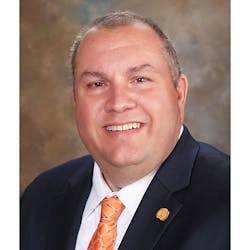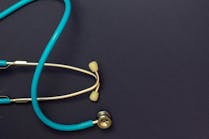Perhaps, the most precious resources in the operating room (OR) are the instruments used on patients. Whether used for surgeries, treatment or other care, these devices, in essence, can be lifesaving or life-endangering for patients.
“Surgical instruments are one of any healthcare system’s most valuable assets,” emphasized Juan Ramos, BSBA, CRCST, CIS, CHL, LGBC, CSD Lead Consultant, Aesculap. “We should do everything we can to preserve their value. Instruments are central to safe and effective patient care.”
Unusable devices are costly
What is the impact of malfunctioning, unsterilized or unsafe instruments in the OR and patient care?
“‘Poor reporting of patient safety incidents means that there may be as many as 1,500 incidents a year of poor-quality surgical instruments causing harm.’ (Elizabeth D. Dominguez),” Ramos explained. “There is a direct correlation between instrument care and safe patient care. Poor instrument quality can lead to unsatisfied physicians and other team members, surgical delays and operational costs associated with overtime because cases run late. Unsatisfied coworkers and staff can lead to a high turnover rate.”
“This is the cycle from acquisition to repair or replacement,” Fisher stated. “Following the IFUs and using good techniques in cleaning, sterilization, storage, access, tracking, transport and use of the instrument will affect its longevity.”
He added, “Related to safety and care, nothing is more frustrating than having a surgical instrument that does not work. Dull scissors and trocars and graspers that will not hold add to surgeon irritations and lead to potential tissue damage and the need to open multiple sets of instruments. This, in combination, adds time to the surgical procedure. Also, having a rigid endoscope with a dirty distal tip or damaged rod lens affects the surgeon’s ability to see.”
Supply inventory, surgeon performance, and Sterile Processing and Distribution (SPD) service additionally may be affected, expresses Michael Matthews, Director, Clinical Education & Training, Northfield Medical.
“Any device that is functioning sub-optimally is going to require adjustments by the surgeon,” Matthews indicated. “Additionally, device failure creates stress on both operating room staff and reprocessing staff by reducing the number of functional devices in their stock. Increases in stress have been demonstrated to lead to additional mistakes; these mistakes can affect patient outcomes and do additional damage to the remaining stock of devices. The only way for hospitals to break out of the loop is to become proactive in device maintenance and process improvement.”
COVID-19 burdens staff, supplies, care
As the COVID-19 public health crisis continues to rule communities and healthcare, SPD departments provide an essential role tracking, inspecting, cleaning and sterilizing instruments for safe use on patients. SPD teams, however, require the right tools and systems to perform their jobs effectively and shield themselves from infections. Personal protective equipment (PPE), reprocessing chemicals and equipment, and medical device training must be accessible.
“As case numbers continue to increase, it will be vital that the optimization (efficiency) of tray contents, communication among departments, and turnover (both OR and SPD) are at the forefront of decision making,” urges Michelle Lemmons, RN, BSN, PHN, CNOR, Key Surgical.
At the start, much uncertainty revolved around SARS-CoV-2, the virus that causes COVID-19, notes Ramos.
“One main challenge for OR and SPD professionals at the beginning of the COVID-19 pandemic was fear of the unknown,” Ramos indicated. “Is this virus different from any other virus or infectious agent that we work with on a day-to-day basis? Are our systems of precaution sufficient to protect ourselves and others from further contamination?”
He continued, “Another challenge was the scarce supply of PPE around the country. We are all familiar with the isolation precautions: ‘Wear PPE (e.g., gloves, gown), according to the level of anticipated contamination, when handling patient-care equipment and instruments/devices that are visibly soiled or may have been in contact with blood or body fluids.’”1
COVID-19 created barriers and opportunities for medical device education that SPD departments rely on, points out Matthews.
“Education is the backbone of all activities in sterile processing, and many facilities depend on their vendors to provide regular education to their staff,” Matthews explained. “When the COVID-19 response restricted access of vendors to facilities, an unintentional consequence was decreased accessibility to in-person training and education. This has led to an explosion of interest in non-traditional educational sources.”
Rising volumes of procedures in the OR are another concern for SPD and OR departments in the midst of the ongoing crisis, expresses Lemmons.
“While the intraoperative and post-operative cleaning and decontamination of instruments remains the same in the wake of the COVID-19 pandemic, there is a significant emerging challenge for OR and SPD professionals, the upcoming surge in surgical cases,” Lemmons noted. “Many facilities will be looking to regain lost revenue by increasing their surgical case numbers. This increase, while understandable, will certainly place a strain on both departments and device and instrument cleaning, sterilization, storage, access, tracking, transport, use and repair. If not approached with a great level of respect and consideration, these increases carry a substantial risk of causing negative patient outcomes.”
She continued, “Unique considerations include:
- Operating rooms that have set up anterooms for COVID-positive patients (pre- or post-procedure) can cause access, tracking, and transport complications if devices and equipment are needed in these areas.
- Facilities that have outsourced their OR and SPD teams to the intensive care unit (ICU), emergency department (ED), and acute care floors may have complications with communication among staff and an additional need for retraining and staffing as caseloads increase.
- Many sterile processing departments have had the new role of reprocessing N95 masks, which increases the workload of the department and may change the way the department flow is structured.”
Ramos agrees that staff must manage resources wisely to keep pace with the uptick in patient cases.
“Many hospitals around the country are returning to pre-COVID case volumes, and many are ramping up anesthesia, PACU and operating room personnel,” he indicated. “An incremental case volume should, at minimum, be correlated to staffing patterns in SPD. Additionally, as you take on cases, do you know what your actual inventory is? I have seen differences of up to 15 sets between the tracking system and what actually exists.”
Follow the standard rules
How does SPD meet the needs of instrument reprocessing during the continuing COVID-19 crisis?
Fisher recommends using the same supplies and protocols.
“Throughout the pandemic, OR and SPD staff were questioning whether they needed to change their practices and work instructions around cleaning and sterilization,” Fisher said. “The good news is, the virus classification of COVID-19 is affected by the OR and SPD general cleaning and reprocessing instructions. The chemical agents used in the cleaning, disinfecting, and sterilization of surgical devices is effective in neutralizing and killing the COVID-19 virus.”
With all equipment, it is vital to adhere to the instructions for use (IFU) and standards in place, emphasizes Lynn Burbank, DNP, RN, CRNP, Global Senior Manager for Infection Prevention, Olympus Corporation of the Americas.
“New products have emerged with microbiological efficacy claims that may be significant, but have limited evidence supporting long-term use,”Burbank noted. “Emergency Use Authorization (EUA) has allowed access to goods and services that previously went through extensive research to come to market. Although EUA has been necessary, this change in access or utilization has created a multitude of questions that will impact the future of patient care.”
She added, “The most effective practice change has been to stay with what is known. The use of evidence-based practice (EBP) is still the gold standard in patient safety. When utilizing new equipment or products, implement a risk management assessment, audits, and surveys of the effect, i.e. ask, ‘is it fulfilling the claims made by the vendor?’”
Get IFU-educated
How can SPD departments and teams stay informed and confident in their work?
Ramos suggests caring for surgical instruments starts early on, “before generating a purchase order by answering:
- Do I have the equipment needed to process this instrument?
- Do we have the recommended chemicals for the cleaning process?
- Are my staff and the end user trained on this product?
“Once the instrument is in your facility, it’s essential to process it according to the manufacturer’s instructions for use (IFU). It’s also important to continually update the set contents to make sure it reflects your current practice and to ensure you do not have unnecessary instrument inventory and redundant instrumentation in the sets that could potentially damage needed instruments.”
The Association for the Advancement for Medical Instrumentation (AAMI) recently released new guidance to medical device manufacturers about making their IFUs more understandable for processing.
“Medical device manufacturers, regulators, and healthcare technology management experts recently joined forces to solve a long-standing issue for medical device processing: confusing instructions for use (IFUs). These essential instructions explain how to properly clean, disinfect, sterilize and make the device ready for use on the next patient. This updated technical information report, TIR12:2020, Designing, testing, and labeling medical devices intended for processing by health care facilities: A guide for device manufacturers, ‘standardizes manufacturer IFUs for the processing of clinically used medical devices and helps manufacturers understand how well the end users comprehend a device’s instructions and labeling.’”2
AAMI also referenced, “the 2017 update of the standard ANSI/AAMI/ISO 17664, Processing of health care products—Information to be provided by the medical device manufacturer for the processing of medical devices, which details what information must be provided to healthcare facilities (including instructions for pretreatment, cleaning, disinfection, drying, inspection, maintenance and functionality testing, and packaging). It also describes the validation testing that needs to be conducted to ensure each of these processes is suitable for the device…TIR12 now ensures that manufacturers not only know what information they need to provide, but also how to provide it.”2
Additionally, the Association of periOperative Registered Nurses (AORN) announced the publishing of “the 2021 Guidelines for Perioperative Practice with six revised guidelines” and that the “Instrument Care and Cleaning Practice updates in this guideline emphasize the importance of an interdisciplinary team when selecting equipment and instruments as well as establishing and implementing policies and procedures.”3
In regard to training, Northfield Medical developed online videos for staff, shares Matthews.
“Northfield Medical has created a number of video in-services that are now available on-demand, complete with continuing education certificates that are issued after the viewer completes a quiz with a passing grade,” he highlighted. “This shift to on-demand education has a number of benefits, particularly that it can always fit into the schedule of the facility. While this shift in educational delivery was likely to happen eventually, COVID-19 forced the shift much more quickly.”
Managing instruments
What are the processes for cleaning and pre-cleaning instruments?
Ramos first points to the Centers for Disease Control and Prevention (CDC), which “defines cleaning as ‘the removal of foreign material (e.g., soil and organic material) from objects and is normally accomplished using water with detergents or enzymatic products.’”4
Fisher continued, “Effective instrument care begins in the OR bedside with immediate cleaning after use. This starts the breakdown of the bioburden. Often, there are extended periods of time between use and decontamination. The longer the time, the more difficult it can be to eliminate bioburden, especially for instruments with channels or cannulas. The IFU provides the step-by-step instructions on how to effectively clean the instrument or device.”
Ramos adds, “Keep surgical instruments moist at the end of the procedure and transport them to the decontamination area as soon as possible. Additionally, understanding and keeping the purified water system in place is essential for meeting minimum standards and preserving the instruments’ value by avoiding pitting, corrosion, and staining. Pitted instruments can hold microorganisms past sterilization and can lead to surgical site infections. Having a reliable water source should be the first step in caring for your surgical instruments. The water will activate enzymes during the cleaning process and remove mineral deposits from the surgical instruments. Having the correct brushes is essential to preserving the instruments’ passivation layer. When instruments are cleaned using metal brushes, the passivation layer can be scratched, leading to pitting and corrosion.”
Lemmons shares, “The use of a pre-treatment will make the difference between an increase or decrease of biofilm formation and subsequent infection. Pre-treatment products act as a bacteriostatic wetting agent, many of which keep instruments moist for up to 72 hours, inhibiting microbial growth and preventing surgical soil from drying on the instruments. Pre-treatment products promote improved cleaning results during the manual cleaning process in decontamination. Additionally, having a pre-treatment spray that features surfactants and emulsifiers helps pull the surgical soils away from the instrument surface. Water is not enough when the risk of postponed decontamination is increased. Availability and use of pre-treatment products are an absolute must.”
How can instruments be tracked, tested and protected?
Staff and software may be used for instrument tracking, explains Ramos.
“Staff in the OR and Sterile Processing are equally responsible for identifying instruments needing repair, taking them out of circulation as soon as possible and communicating their daily challenges and struggles to the leadership team,” he stated. “When appropriately implemented and maintained, tracking software helps in the care and handling of surgical instruments. Most software on the market today allows for picture integration, IFUs and special instructions. Some software programs can be programmed to reject an item when a critical scan has been missed in the process. For example, an instrument set could be used to scan the OR without a previous scan of the decontamination area and/or sterilizer. Instrument organizers can extend instrument life by securing and organizing them.”
Training helps support staff in the maintenance of devices, notes Matthews.
“Sterile processing must receive the training and tools necessary to identify early warning signs that a device might not function in the way the surgeon requires,” he emphasized. “In cases where early warning signs are difficult to detect, power tools for example, facilities should move to a preventative care plan; this is best accomplished with a tracking system that can determine how many times a single device has been used since its last preventative maintenance. As surgical devices become more complex, they also break in more subtle ways. Enhanced visual inspection tools, such as digital microscopes and borescopes, should become a standard expectation in all sterile processing departments.”
Protective supplies and testing equipment help maintain use and safety of instruments, expresses Cheron Rojo, AA, CRCST, CIS, CER, CFER, CHL, Clinical Educator Coordinator-SPD, Healthmark Industries.
“One such new tip protection is the ‘Robotic Tip Guard,’ a specialized tip protector approved by INTUITIVE for robotic arms (Figure 1),” Rojo said. “This low-linting tip guard protects the delicate instrumentation during sterilization, transport and storage.”
He continued, “ANSI/AAMI ST79 recently provided recommendations in their new amendment on the inspection of insulated instrumentation stating ‘cables/cords are also a source of concern and need to be inspected and checked for integrity and continuity’ (ANSI/AAMI, 2020). It also recommends that ‘instruments intended for use with electric current should be tested for integrity each time it is processed’ (ANAI/AAMI, 2020).5 The integrity of an insulated instrument is conducting a test while using insulation tester equipment with the appropriate accessories designed for that instrument (Figure 2). Regarding the testing for continuity, another type of equipment is needed (Figure 3). A continuity tester is used to test the unbroken connection between the two points from proximal to distal inside the cable/cord. A reusable cable/cord may pass the integrity test with an insulation tester but may not pass the continuity test.”
With flexible endoscopes specifically, Fisher stresses, “having a working leak tester is critical. Leak testing should happen both before and after cleaning. Equally important is to have the correct size and length of cleaning brushes. A brush that is too small will not be effective for reaching all areas of the working channel. A brush that is too large can damage the working channel, leading to contamination and a potential costly repair.”
Prepare for the future
What is on the horizon for next-generation SPD and instrument care?
“I believe as instrumentation becomes more complex, so will the cleaning, reprocessing and sterilization requirements,” Fisher envisioned. “It is important that as manufacturers and healthcare providers, we continue the dialogue about the importance of following the cleaning instructions and IFUs. Also, we will continue to see single-use devices reach the market.”
Matthews foresees expanded partnerships, roles and education.
“It is critical that sterile processing teams and their vendor partners collaborate to create better solutions that enable proactive repairs and better training to identify early warning signs of device damage,” he said. “Sterile Processing Technicians themselves will see their positions become more technically complex, which will create a massive demand for innovative educational resources.”
Ramos predicts growth in automated technology, staff certification and college programming.
“With the transformation of Sterile Processing Departments worldwide, we see the continuous development of the UDI and other forms of tracking technologies that would allow complete traceability for every instrument,” he stated. “Machine learning and engineering development advancements will bring us closer to a more automated quality management system where instruments will be inspected for defects by a machine before assembly to ensure that they meet the expected quality standards. I also foresee advancements in the automation of sets assembly as healthcare systems understand and realize the value of standardization. As professional organizations continue to push for mandatory certification at the state level, I see the sterile processing field transforming. In a few years, we will see many community colleges offering an associate degree program in sterile processing. The SPD of the future is a hybrid of good manufacturing practices and safe patient care.”
References:
1. Guideline for Isolation Precautions: Preventing Transmission of Infectious Agents in Healthcare Settings (2007), https://www.cdc.gov/infectioncontrol/guidelines/isolation/index.html
2. AAMI Guidance Helps ‘Clean Up’ Medical Device Instructions for Use, https://pressroom.aami.org/posts/pressreleases/aami-guidance-helps-clean-up-medical-device-i-1
3. AORN RELEASES 2021 GUIDELINES FOR PERIOPERATIVE PRACTICE, https://www.aorn.org/-/media/aorn/about-aorn/newsroom/press-releases/2021/2021-guidelines-for-perioperative-practice.pdf?la=en&hash=1C2312C43E414846E1285C5CFC0998DC
4. Guideline for Disinfection and Sterilization in Healthcare Facilities (2008), https://www.cdc.gov/infectioncontrol/guidelines/disinfection/cleaning.html
5. ANSI/AAMI ST79: Comprehensive Guide to Steam Sterilization and Sterility Assurance in Health Care Facilities, Amendment A.2 (2020). Arlington, VA: Association for the Advancement of Medical Instrumentation; 2017.

Ebony Smith
Ebony Smith was previously Managing Editor for Healthcare Purchasing News.











